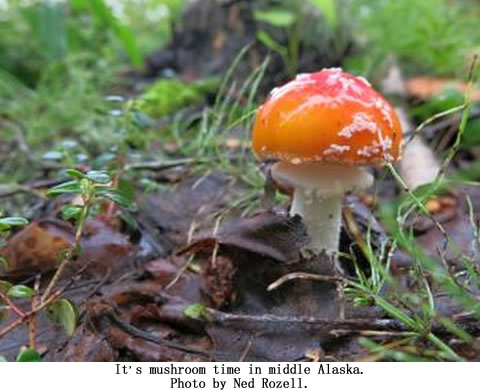 |
Canku Ota
|
 |
|
(Many Paths)
|
||
|
An Online Newsletter
Celebrating Native America
|
||
|
November 2014 - Volume
12 Number 11
|
||
|
|
||
|
Late Summer Arrives
in the Boreal Forest
|
||
|
by Ned Rozell - Geophysical
Institute
|
||
|
The last time I wrote about hiking through the North Campus of the University of Alaska Fairbanks, summer was a puppy crashing into your shin. Now it has a white muzzle. I note this maturity while moving through a nice chunk of boreal forest in the mile between my workplace and my home. For a lot of reasons, I’m lucky to be able to commute on foot, bike or ski some days. August is a wet time for us here in Fairbanks. A somewhat predictable shift in the jet stream shuttles airborne moisture through the green alley between the Kuskokwim Mountains and the Alaska Range. In other seasons, snow and rain slam into mountain walls, keeping us dry. This summer has been different from remembered ones, with twice the average amounts of rain falling on my little world in June and July. This has swelled the sluggish creeks that ooze through this 1,000-plus acres of spruce, birch, and Labrador tea. On days of heavy rain, wood chips carted in to enhance trails have floated in unison, a regatta sailing on. In addition to requiring more labor from the attentive trail groomers who work for the university, the coolness and inches of rain in June and July have resulted in the following observations. 1. Fabulous mushrooms. The fruiting bodies of fungi beneath the surface have popped up like sudden trolls. Some are wet and phallic. Others have spongy heads as large as dinner plates. 2. Ample mosquitoes. Enduring pockets of water throughout the forest have provided the females convenient places to lay eggs. The incubating cups have remained liquid, allowing remarkable birthing success. Ugh. 3. No fire smoke. The nostalgic scent of vaporized spruce and willow has drifted in just once, from a large fire on the Kenai Peninsula. For most of the summer, the air has been clear and smells like the color green, bitter and fresh. 4. Happy trees. Spruces in these parts have been thirsty in recent summers, but the muskeg is now sopping. The spruce tops are nodding with green cones. Red squirrels, which feed almost exclusively on the seeds within the cones, are in great number. White-winged crossbills chitter their happy songs from the treetops. Their beaks, which fit together like crossed fingers, allow the year-round residents to open cones with ease. Perhaps they sense prosperity. 5. A gathering of sandhill cranes. A few dozen birds stride inside a fenced plantation of balsam poplar trees, maybe feeding on grasshoppers. The group spent the summer somewhere to the north, some of them emerging from eggs on tundra. Their prehistoric croaks ring when a runner passes with his dog. 6. A return to stillness. All the Townsend’s warblers and ruby-crowned kinglets have done their thing. The males spend no more energy on their lovely, rhythmic, brief songs. The new birds of the year are invisibly gobbling up insects as they prepare for epic journeys southward. Somehow, they will never forget these trees of their birthplace. Most will return to perch on a crooked black spruce branch here next April or May. Geophysical Institute at the University of Alaska Fairbanks Scientists at the Geophysical Institute study geophysical processes in action from the center of Earth to the surface of the sun and beyond. The Institute turns data and observations into information useful for research, state and national needs. Much of this research is performed by Institute faculty, staff and students as part of their regular work. http://www.gi.alaska.edu/ |
|
|
||
|
|
||
| Canku Ota is a free Newsletter celebrating Native America, its traditions and accomplishments . We do not provide subscriber or visitor names to anyone. Some articles presented in Canku Ota may contain copyright material. We have received appropriate permissions for republishing any articles. Material appearing here is distributed without profit or monetary gain to those who have expressed an interest. This is in accordance with Title 17 U.S.C. Section 107. | ||
|
Canku Ota is a copyright ©
2000 - 2014 of Vicki Williams Barry and Paul Barry.
|
||
 |
 |
|
|
The "Canku
Ota - A Newsletter Celebrating Native America" web site and
its design is the
|
||
|
Copyright ©
1999 - 2014 of Paul C. Barry.
|
||
|
All Rights Reserved.
|
||
 It’s
early August, 118 miles from the Arctic Circle. Time for a walk
to work.
It’s
early August, 118 miles from the Arctic Circle. Time for a walk
to work.